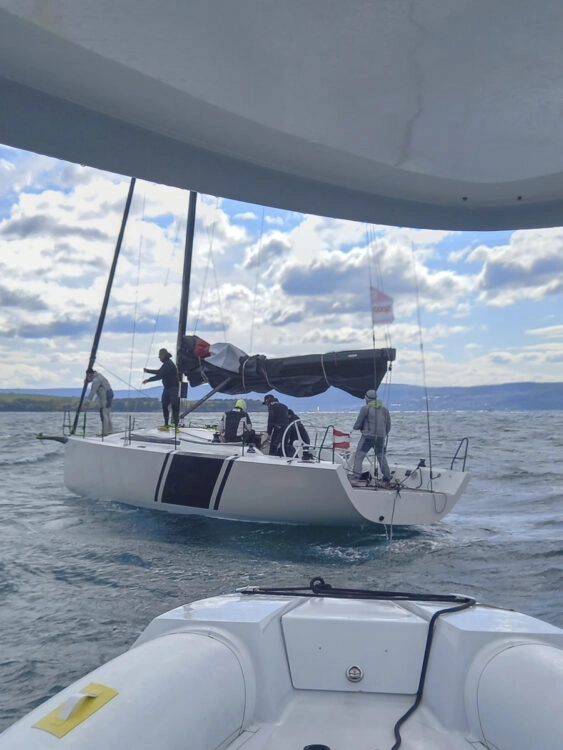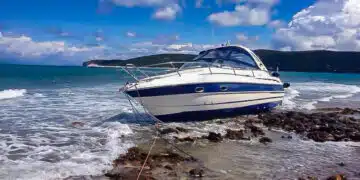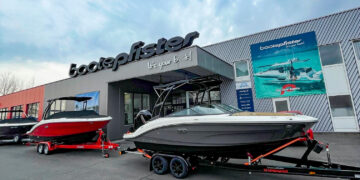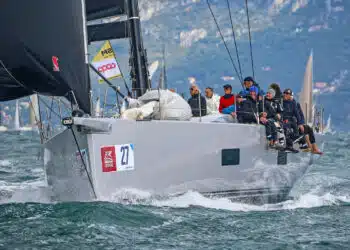It is considered the largest regatta in the world: the Barcolana off the Italian city of Trieste. Up to 1,800 boats and yachts take part in the sporting spectacle, up to 20,000 sailors are actively involved, and on land there is regularly a large sailing festival with up to a quarter of a million spectators. In 2020, the regatta had to be cancelled – due to excessively bad weather. This year, the conditions were not much better, but the race took place – which was not without consequences. Sea Help was in constant use.
After the nearly 1,800 boats and yachts had to stay in port last year because of all too bad weather, the regatta management of the Barcolana decided this year to let the people’s race, in which everyone can participate, take place. A daring decision, as it soon turned out, because this time it did not look much better: the Bora swept with up to 42 knots over the approx. 15 nautical miles long course. Registered had 1,722 boats and yachts.
There was plenty to do for Sea Help rescuers at the 53rd edition
And so there was plenty to do for Sea Help rescuers on the Italian Adriatic, who helped secure the race. “This year, the bora was clearly the protagonist in the 53rd edition of the Barcolana,” said Enrico Moz of the operations center in Italy. Although the race committee had excluded smaller boat classes from participating in the regatta in good time before the strong winds, and the race of the Class 2 yachts had also been stopped to avoid anything worse, the rescue forces had nevertheless had to become active a total of twelve times.
“The boats participating in the regatta were put through their paces and there were numerous failures. A total of 41 people were rescued,” Enrico Moz summed up after the exceptional race. One man suffered a head injury, another person fell overboard, and one yacht even sank, he said. “In fact, in the Gulf of Trieste, it blew continuously for four days until the regatta finally started at 10:30 a.m. on Sunday, Oct. 9,” Moz said, by which time the wind had reached peaks of up to 50 knots.
This year, the number of deployments was particularly high – there were rudder and even mast breaks
SeaHelp participated in the Barcolana, as in previous years, to provide assistance and press support. This year, the number of deployments was particularly high, Moz says, which is “no wonder in these conditions”; there were many rudder breaks and also some mast breaks. Videos are circulating on the Internet of large yachts almost running over smaller yachts, and of maxis whose rig breaks and collapses – you can get a rough idea of what it looked like on the water, Moz says.
The Barcolana course consists of a quadrangle with fixed vertices in the Gulf of Trieste with a total length of 21 kilometers. The starting line is located between Barcola and Miramare, while the arrival of the yachts is expected in front of the historic Piazza Unità d’Italia. After the start, the race goes for 4.3 nautical miles in the direction of 210 degrees until the first buoy, then follows a short stretch in the direction of 332 degrees. In front of Miramare Castle, between buoys 2 and 3, the race will then continue for four miles, after which it will return to Barcola for about 3.7 nautical miles along the coast. The last part of the race starts at Faro della Vittoria and takes the crews directly to the finish.
At the passage of the first buoy, which took place only about 15 minutes after the start, there was still a gap of 40 seconds between Way of Life and Arca SGR, in third place Adriatic Europa with Dusan Puh passed the buoy. The positions remained unchanged until the passing of the second buoy, but then on Way of Life on the upwind course the attachment of the mainsail to the masthead (halyard swivel) broke as a result of an exceptionally strong gust of wind.
After an exciting race, the winner of this year’s Barcolana was Arca SGR
Arca SGR took the lead and saved it all the way to the finish just 45 minutes after the start – a great victory that was exuberantly celebrated at the third buoy in front of Miramare Castle. For owner Furio Benussi it was already the fifth time that he could win the Barcolana.
Because of the strong winds, the race committee had decided to shorten the race to avoid exposing the boats to the strong gusts of wind in Barcola. The sailors of Furio Benussi, Lorenzo Bressani and Stefano Spangaro, all from Trieste, reached the finish line with their 100 footer, which has also been victorious in the Sydney-Hobert Race and in the Rolex Middle Sea Race, almost two minutes ahead of Way of Life, which caught up again and could still take second place.
Third place went to Maxi Jena with Milos Radonjic, while fourth place went to Adriatic Europa: Dusan Puh literally flew across the water in his sixty-footer. Finishing fifth was Woodpecker Cube of Alberto and Claudia Rossi, the first yacht in the cruiser class.
Conservative regatta decisions in favor of safety at sea
Furio Benussi of the winning Arca SGR summed up after the race, “great result, great crew.” It was “great satisfaction” they had sailed against Spirit of Portopiccolo, who everyone thought were unbeatable; “today we beat them”. Lorenzo Bressani, looking back, assessed the race as “very challenging”.
They had approached it “with great attention”and had made many “conservative decisions to be able to ensure our safety and that of the crews at sea near us”. The launch, he said, was “very complex”but “all the decisions we made were right”. Always focused and fast, they would have reached up to 27 knots of speed. barcolana.it
















